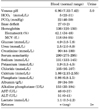Severe ketoacidosis with a blood pH below 7.0 is only rarely seen in other diseases except type 1 diabetes. This paper reports a case of severe ketoacidosis secondary to an eating disorder.
A 46-year-old woman presented to the emergency department with an acute onset of shortness of breath. She has a history of an eating disorder, an anxiety disorder, and hypothyroidism. Her body mass index was 19. Examination of the initial vital signs revealed the following: pulse, 91 beats/min; body temperature, 34.9℃; respiratory rate, 35 breaths/min; oxygen saturation, 100% on room air; and blood pressure, 130/70 mmHg. Urinalysis revealed specific gravity of >1.030, pH of 5.5, negative results for glucose, and positive results for ketone bodies (>150 mg/dL). Her serum glucose level was 4.9 mmol/L. Venous blood gas analysis revealed the following: pH, 6.96; HCO3−, 5 mmol/L, pCO2, 22 mmHg; base deficit, 27 and anion gap, 21. the patient showed a high anion gap metabolic acidosis with proper respiratory compensation. Results of the blood analysis are shown in Table 1. The osmolar gap was 20, which suggested unmeasured anions. However, tests for ethanol, salicylate, ethylene glycol, and methanol levels were negative. The serum ketone test was positive. These laboratory parameters made us rule out diabetic ketoacidosis and alcoholic ketoacidosis as the cause of the metabolic acidosis. Initially, the patient received a 5% dextrose solution in normal saline (D5W NS). After 12 hours of hospitalization on D5W NS, venous blood gas analysis revealed improved results: pH, 7.18; HCO3−, 5 mmol/L; and pCO2, 13 mmHg, with a base deficit of 23.
Initially, the family and the patient told us that the patient had been doing much better in the last 2 weeks regarding her eating habits. We asked her repeatedly and she finally admitted to giving her food to her dog underneath the table. Moreover, she had been taking stool laxatives.
In a patient with ketonemia, low glucose levels excluded diabetic ketoacidosis as the cause of severe metabolic acidosis.1 Negative results for laboratory tests for toxicology and toxic alcohol levels led us to consider starvation as the etiology of the acid-base imbalance.2 Ketoacidosis secondary to starvation is due to diminished insulin secretion that leads to an increase in lipolysis and ketogenesis.3
Eating disorders not otherwise specified are a category of eating disorder that includes patients with early aberrant eating patterns and weight management habits who do not meet the criteria for anorexia or bulimia nervosa.4 It occurs in approximately 3-5% of women aged between 15 and 30 years in Western countries.5 Patients with bulimia ten to abuse laxatives. It prevents the absorption of calories, which may aggravate starvation ketoacidosis.6
In conclusion, starvation should be considered as one of the causes of severe ketoacidosis in individuals with an eating disorder, even when the patient denies diet restriction.
References
3. Chalasani S, Fischer J. South beach diet associated ketoacidosis: a case report. J Med Case Rep. 2008; 2:45.

4. American Psychiatric Association. Diagnostic and statistical manual of mental disorders. 5th ed. Arlington: American Psychiatric Association;2013.




 PDF
PDF ePub
ePub Citation
Citation Print
Print



 XML Download
XML Download